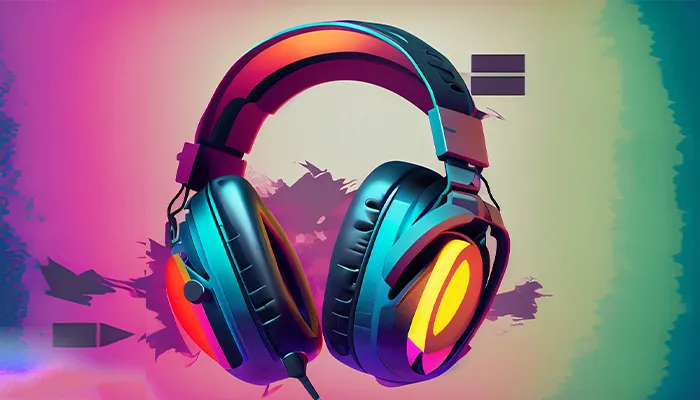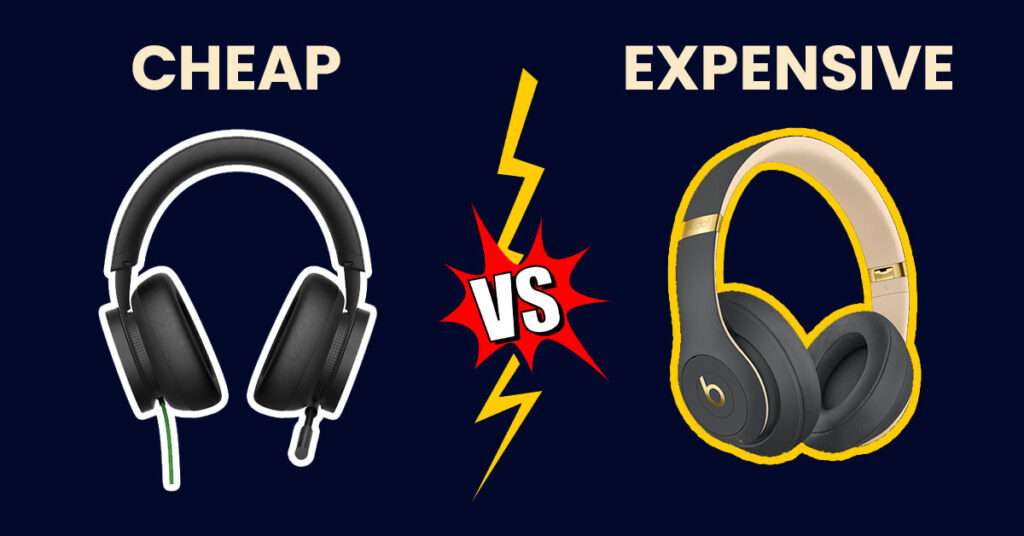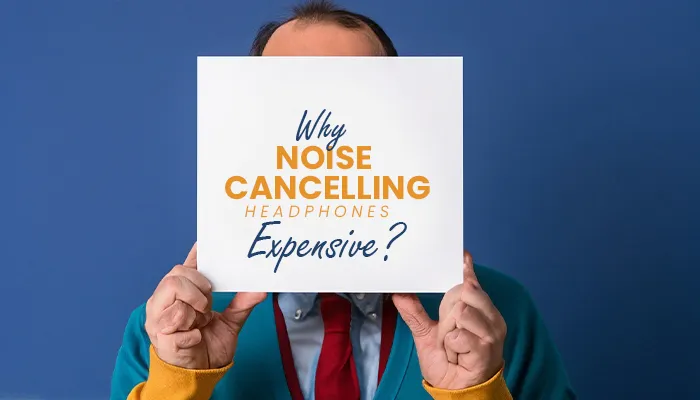We live in a world where music is an essential part of our lives, and sometimes we crave an escape from the noisy chaos around us. That’s where noise-canceling headphones come into play, providing our ears with a peaceful respite. But have you ever questioned why these headphones are so expensive?
It’s not just about their sleek looks and cool features. The fact is that top-notch noise-canceling headphones need a lot of work, which explains why they can be rather pricey.
Noise-canceling headphones are usually more expensive than regular headphones because they have better audio quality, cancel more noise, fit better, and last longer. They also need power, so they have separate compartments for batteries which contributes to their bulk, weight, and price. However, a hefty price tag doesn’t always mean an optimum value. Sometimes, you pay for branding and style.
This article will explain the enigma around noise-canceling headphones’ high price, the Pros and Cons of Noise Cancelling Headphones, and the elements that go into producing their excellent sound quality.
Reasons Why Are Noise-Canceling Headphones So Expensive?
Here are some Facts and Reasons why Noise Cancelling headphones are Expensive.
- Technology Behind Noise Cancelling Headphones
- Cost of Research and Development
- Materials Used in Noise Cancelling Headphones
- Marketing and Branding Costs
- Supply and Demand
Technology Behind Noise Cancelling Headphones
The key to their exceptional performance lies in the advanced active noise cancellation (ANC) technology they employ. These headphones can efficiently block undesired outside sounds by using built-in microphones and sophisticated signal processing.
The ANC system analyzes and generates inverse sound waves that counteract the incoming noise, resulting in a quieter listening experience. This intricate technology, developed through extensive research and engineering, sets noise-canceling headphones apart and contributes to their higher cost.
Cost of Research and Development
The price of noise-canceling headphones reflects the significant investment in research and development. These investments are necessary to drive technological advancements, meet market demands, and ensure the highest levels of quality and performance.
According to Statista “Sony’s research and development (R&D) expenses have shown a consistent upward trend from fiscal year 2011 to 2021. Their investment in R&D has increased steadily over the years, with expenditures growing from 3.99 billion U.S. dollars in 2011 to 5.51 billion U.S. dollars in 2021. This significant and continuous investment showcases Sony’s strong commitment to innovation and product development, including their line of noise-canceling headphones.“
Materials Used in Noise Cancelling Headphones
The construction of noise-canceling headphones involves meticulous selection and integration of high-quality materials, each playing a crucial role in delivering an exceptional audio experience. Let’s explore the key materials commonly used in noise-canceling headphones:
Premium Drivers
The heart of any headphone lies in its drivers. Noise-canceling headphones often incorporate dynamic drivers made of lightweight yet robust materials such as neodymium magnets and high-grade diaphragms.
These components are engineered to deliver accurate sound reproduction, capturing even the finest nuances of your favorite tracks.
Noise Isolation Materials
To effectively block out external noise, noise-canceling headphones utilize specialized materials for sound insulation. This can include dense foam or memory foam ear cushions that form a secure seal around your ears, preventing sound leakage and minimizing the intrusion of ambient noise.
Circuitry and Electronics
Active noise cancellation technology relies on advanced electronic components and circuitry. These components, including microphones, processors, and amplifiers, are carefully integrated into the headphones to ensure optimal performance and efficient noise reduction.
Premium Finishes
Noise-canceling headphones often feature premium finishes, such as sleek metallic accents or soft-touch matte coatings. These aesthetic elements not only enhance the overall design but also contribute to a premium feel and visual appeal.
By combining these carefully chosen materials, noise-canceling headphones are meticulously crafted to provide both comfort and immersive sound quality.
Marketing and Branding Costs
Marketing and branding costs significantly contribute to the higher price tag of noise-canceling headphones.
Manufacturers invest substantial resources in extensive marketing campaigns, influencer collaborations, and retail presence to create brand awareness and position their headphones as top-of-the-line products.
These efforts require significant financial investments, which are ultimately factored into the pricing of the headphones.
Supply and Demand
Supply and demand affect the price of noise-canceling headphones because the higher the demand for a product, the higher the price will be.
If there is a limited supply of noise-canceling headphones and a high demand for them, then the price will increase. On the other hand, if there is a high supply of noise-canceling headphones and low demand for them, then the price will decrease.

How Much Should You Spend on Noise Cancelling Headphones?
Determining how much to spend on noise-canceling headphones depends on various factors, including your personal budget, desired features, and audio preferences. While there is a wide range of options available at different price points, here are some general guidelines to consider:
- Entry-Level Options: If you’re on a tighter budget or new to noise-canceling headphones, entry-level options can provide a decent listening experience without breaking the bank. These headphones typically range from $50 to $150 and offer basic noise cancellation and audio quality.
- Mid-Range Choices: For better sound quality and more advanced features, such as customizable sound profiles or longer battery life, consider mid-range options. These headphones typically range from $150 to $300 and offer a good balance between price and performance.
- Premium Selections: If you’re an audiophile or prioritize top-tier sound quality and advanced noise cancellation technology, investing in premium noise-canceling headphones can deliver an exceptional audio experience. Premium models often range from $300 to $500 or more, offering the latest innovations, superior build quality, and enhanced comfort.
It’s essential to carefully evaluate the specific features, reviews, and customer feedback for the headphones within your desired price range. Additionally, consider factors like comfort, durability, and any additional features that align with your needs and preferences.

Cheap Vs Expensive Noise-Canceling Headphones
When comparing cheap and expensive noise-canceling headphones, there are notable differences in terms of noise-canceling technology, audio quality, build quality, comfort, and additional features.
For example, inexpensive noise-canceling headphones like the Anker Soundcore Life Q20 offer basic noise reduction capabilities but may not provide the same level of noise isolation as high-end models like the Sony WH-1000XM4.
Expensive options often deliver superior audio quality, such as the Bose QuietComfort 35 II with its balanced sound profile, while cheaper alternatives like the JBL TUNE 600BTNC may lack the same level of audio clarity and balance.
Moreover, premium noise-canceling headphones, like the Bose noise canceling 700, typically feature durable build materials and enhanced comfort through adjustable headbands and plush ear cushions, whereas budget-friendly options might compromise on construction quality and comfort.
Lastly, expensive noise-canceling headphones often come with additional features like touch controls, wireless connectivity, and compatibility with virtual assistants, which may be absent in cheaper models.
Advantages of Noise Cancelling Headphones
Noise Reduction
The primary advantage of noise-canceling headphones is their ability to reduce or eliminate unwanted background noise, providing a more immersive and focused listening experience. This is particularly beneficial in noisy environments like airplanes, offices, or busy city streets.
Enhanced Audio Quality
By reducing external noise, noise-canceling headphones allow for clearer and more detailed audio reproduction. This enables listeners to enjoy their favorite music, podcasts, or movies without distractions, and with improved clarity and depth.
Increased Focus and Productivity
Noise-canceling headphones can help improve concentration and productivity by creating a quieter environment. This is particularly useful for students, professionals, or anyone who needs to work or study in noisy surroundings.
Travel Comfort
When traveling, noise-canceling headphones can significantly reduce the constant drone of engines or other ambient noises. This can make long flights or commutes more enjoyable and relaxing, allowing travelers to rest or engage in their preferred entertainment.
Hearing Protection
Noise-canceling headphones can act as a form of hearing protection by reducing exposure to loud noises. This can be particularly important in environments where prolonged exposure to high decibel levels may be detrimental to hearing health.
Disadvantages of Noise-Cancelling Headphones
Price
Noise-canceling headphones often come at a higher price compared to regular headphones, mainly due to the advanced technology and features they incorporate. This can be a limiting factor for individuals on a tight budget.
Sound Quality Trade-Off
While noise-canceling headphones generally offer good audio quality, some models may have a slight compromise in sound quality compared to similarly priced non-noise-canceling headphones.
The noise-canceling technology can subtly affect the audio signature, which may not be ideal for audiophiles or those seeking the utmost accuracy in sound reproduction.
Battery Dependency
Noise-canceling headphones require power to operate the noise-canceling feature. This means they rely on built-in batteries, which need to be charged periodically.
Forgetting to charge the headphones or running out of battery during use can be inconvenient, especially when noise reduction is a priority.
Potential Audio Artifacts
In some cases, noise-canceling technology may introduce subtle audio artifacts or a feeling of pressure in the ears. This is a rare occurrence, but it can affect a small percentage of users.
Limited Noise Reduction for Certain Frequencies
While noise-canceling headphones excel at reducing constant low-frequency sounds like airplane engine hum or air conditioning noise, they may not be as effective at canceling out sudden, high-pitched noises or human voices.
Factors to Consider When Choosing Noise-Control Headphones
When it comes to finding the perfect pair of noise-canceling headphones, several key factors should be considered to ensure a truly immersive and enjoyable audio experience.
Noise-Canceling Capability
Evaluate the effectiveness of the noise-canceling technology. Look for headphones with advanced active noise cancellation (ANC) that can effectively block out external sounds, allowing you to escape into your own world of music or focus on tasks without distractions.
Sound Quality
Consider the overall audio performance of the headphones. Look for models with a balanced sound signature, clear instrument separation, and accurate reproduction of different frequencies.
Pay attention to bass response, midrange clarity, and detailed high-end representation to ensure an enjoyable listening experience.
Comfort and Fit
Opt for headphones that provide long-lasting comfort. Look for adjustable headbands, plush ear cushions, and lightweight designs. A comfortable fit is crucial for extended use, ensuring that you can wear the headphones for hours without discomfort.
Battery Life
Check the battery life and charging capabilities. Longer battery life allows for uninterrupted use, especially during long trips or work sessions.
Consider headphones with quick charging options and the ability to use them in passive mode when the noise-canceling feature is turned off or when the battery is drained.
Durability and Build Quality
Assess the build quality of the headphones. Look for sturdy materials that can withstand regular use and potential travel hazards. Consider factors like robust hinges, quality cables, and reinforced headbands for enhanced durability.
Additional Features
Explore the availability of additional features that align with your preferences. This may include wireless connectivity, intuitive controls, customizable sound profiles, companion apps for firmware updates, or compatibility with virtual assistants.
Price and Value
Finally, consider your budget and the value offered by the headphones. While high-end models tend to offer advanced features and superior performance, there are often mid-range options that provide a good balance between quality and affordability. Evaluate the price in relation to the overall features and benefits provided.
Verdict
Noise-canceling headphones come with a higher price tag due to factors such as advanced technology, extensive research and development costs, marketing and branding expenses, supply and demand dynamics, and the use of high-quality materials.
While they offer exceptional noise reduction and audio quality, it’s essential to consider factors like personal budget, desired features, and specific needs when deciding how much to spend on noise-canceling headphones.
Related Posts
- Bose Noise Cancelling 700 Headphones Review
- The Science Behind Noise Cancelling Headphones
- Do Noise Cancelling Earbuds Protect Hearing?
- Charging Bluetooth Headphones During Use: Is It Possible? - January 9, 2024
- Why Over-Ear Headphones Best for Hearing Health? (7 Reasons) - December 12, 2023
- Fixing the Bose Earbuds Not Charging in Case Problem: Solutions That Work - November 24, 2023

